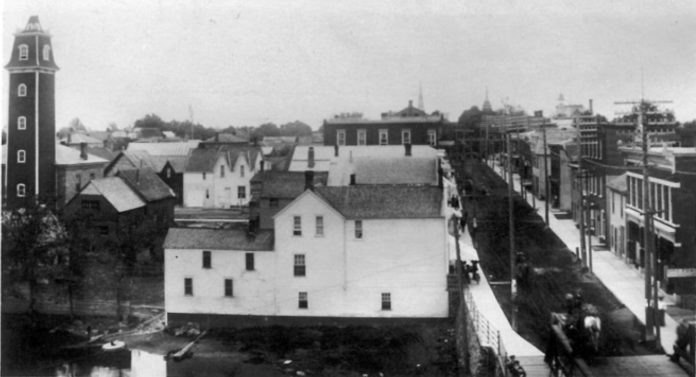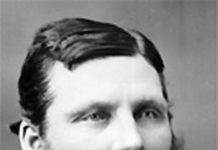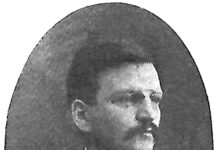The village of Kemptville was an exciting place at the end of 1898. The village council had been reduced to just the Reeve and two councillors due to the resignation of two experienced men, W. H. Anderson and J. G. Pelton, who objected to what they saw as the extravagance of their younger colleagues, G. Howard Ferguson and James MacGregor. But, taking control of council, Ferguson and MacGregor took the opportunity of spending even more money on paving sidewalks and hiring a contractor to finally replace the aging and dangerous swing bridge which crossed the South Branch at Bridge Street.
Frustrated at being excluded from council through their own misjudgement, Anderson and Pelton took out an injunction against council, stopping all work on the bridge in December, 1899. The old bridge was already demolished, and no new one could be built until the courts decided on the injunction. The stage was set for an interesting municipal election that same month to select the village council for 1899.
At a very crowded nomination meeting at the Town Hall on the afternoon of December 27, no fewer than eighteen names were put forward to run for council, and eight for Reeve. Everyone nominated had a chance to address the meeting, and the main issue was the money spent on the paving and the bridge. At times, the discussion became heated and personal. Ex-councillor Anderson gave his belief that the outgoing Reeve was “conscientiously honest”, but as for Ferguson and MacGregor, “he thought differently…In their Bibles at home there is a passage which says ‘the meek shall inherit the earth’, but they read it, ‘the cheeky shall get there’”.
By the end of the meeting, two candidates emerged for the Reeve’s position: the outgoing Reeve, George Taylor, who had proved incapable of controlling the council that year, and Angus Buchanan. Buchanan was a local businessman who had served as County Councillor for the previous two terms, and had been the Liberal candidate in the two previous provincial elections. He had failed in both bids. He had also been one of the parties who had taken out the injunction against the bridge project, as had four of the candidates for councillor.
The election threw up the strangest group of winners, possibly showing that the electors of Kemptville were enjoying the political entertainment. In 1899, most people could not vote in any election, although some women did have the right to vote municipally. The 1899 election saw the highest number of votes cast in any municipal election in the village, a total of 291, and getting the vote out had involved transporting a great number of the old, the sick and the women. So busy were the polling stations that some had to return three or four times before getting in, and around a dozen never got in at all.
Angus Buchanan was elected Reeve with a majority of just 19, and the two candidates who had signed the injunction were also returned. But so were Ferguson and MacGregor. In fact, Ferguson topped the poll, followed an “ injunctionist”, Samuel Patterson (12 votes behind), then MacGregor and finally W. H. Mundle, another injunctionist, setting up a fascinating scenario for the new council. And the voters looking for more fun were not to be disappointed.
One of the first items of business was moved by the two new councillors: that they and Buchanan be a committee to “inquire into all matters requiring immediate attention in connection with the corporation of Kemptville”. It was obvious that conflict was inevitable and that Ferguson and MacGregor were now the minority and vulnerable to whatever the others might bring against them. But, as he was to prove again and again in his political career, Howard Ferguson was at his most dangerous when he was attacked. Before his three council opponents could organise their committee of inquiry, Ferguson and MacGregor brought a case before the High Court in Toronto to have the three men unseated. Their reasoning was that Buchanan, Mundle and Patterson had brought an injunction against the village and were therefore in a conflict by having positions on the village council.
The courts ruled against the injunctionists, and Kemptville found itself holding a nomination meeting for new councillors for the fifth time sixteen months. And once again a record number of votes were cast – 300 this time – and once again the Clothier Bridge was the main issue under discussion. The first meeting of the new council produced a resolution to approach the provincial government for help in erecting the new bridge. It was eventually built, but not without further division and a further renovation provided a safe and stable structure that remained in place until the 1960’s.
The controversy over the Clothier Bridge did nothing to harm G. Howard Ferguson’s career. Quite the opposite, in fact. In the next municipal election, in 1900, he was elected Reeve, a position he held until the end of 1902, before moving on to provincial politics. While Reeve, he also became an owner of the Kemptville Telegram, set up as a Conservative rival to the Advance. In 1913, he would buy out the Advance, keep the name and go on to great things on a wider stage than Kemptville could provide. But he never lost the edge that brought him that early success with a bridge over troubled water.









